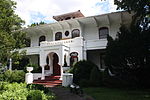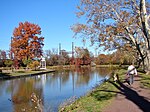Phillipsburg School District
The Phillipsburg School District is a comprehensive public school district in Phillipsburg, in Warren County, New Jersey, United States. The district serves students in pre-kindergarten through twelfth grade from a population of 16,000 people and an area of 3.2 square miles (8.3 km2) in Phillipsburg and other neighboring communities along the Delaware River. The district is one of 31 former Abbott districts statewide that were established pursuant to the decision by the New Jersey Supreme Court in Abbott v. Burke which are now referred to as "SDA Districts" based on the requirement for the state to cover all costs for school building and renovation projects in these districts under the supervision of the New Jersey Schools Development Authority.As of the 2020–21 school year, the district, comprised of five schools, had an enrollment of 3,877 students and 329.0 classroom teachers (on an FTE basis), for a student–teacher ratio of 11.8:1.The district is classified by the New Jersey Department of Education as being in District Factor Group "B", the second-lowest of eight groupings. District Factor Groups organize districts statewide to allow comparison by common socioeconomic characteristics of the local districts. From lowest socioeconomic status to highest, the categories are A, B, CD, DE, FG, GH, I and J.The district's high school serves students from the Town of Phillipsburg and from five sending communities at the secondary level: Alpha, Bloomsbury (in Hunterdon County), Greenwich Township, Lopatcong Township and Pohatcong Township, as part of sending/receiving relationships with the respective school districts.
Excerpt from the Wikipedia article Phillipsburg School District (License: CC BY-SA 3.0, Authors).Phillipsburg School District
Marshall Street,
Geographical coordinates (GPS) Address Nearby Places Show on map
Geographical coordinates (GPS)
| Latitude | Longitude |
|---|---|
| N 40.69609 ° | E -75.179951 ° |
Address
Marshall Street 521
08865
New Jersey, United States
Open on Google Maps









